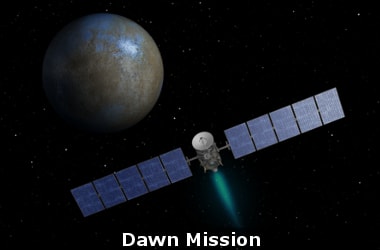
NASA's Dawn mission has found evidence of organic material on Ceres.
Ceres is a dwarf planet and the largest body in the main asteroid belt between Mars and Jupiter.
Scientists discovered the material in and around a northern-hemisphere crater called Ernutet.
Organic molecules are novel to scientists because they are necessary, though not sufficient components of life on Earth.
The discovery makes it to the growing list of bodies in the solar system where organics have been found.
Organic compounds have been found in certain meteorites. They have also been inferred from telescopic observations of several asteroids.
Ceres shares many commonalities with meteorites rich in water and organics - in particular, a meteorite group referred to as carbonaceous chondrites.
This discovery further strengthens the connection between Ceres, these meteorites and their parent bodies.
This is the first clear detection of organic molecules from orbit on a main belt body.
Data supports the idea that organic materials are native to Ceres.
The carbonates and clays previously identified on Ceres provide evidence for chemical activity in the presence of water and heat.
This raises the chance that the organics were similarly processed in a warm water-rich environment.
The organics discovery makes an addition to Ceres' attributes associated with ingredients and conditions for life in the distant past.
Earlier studies have found hydrated minerals, carbonates, water ice, and ammoniated clays that must have been altered by water.
Salts and sodium carbonate, such as those found in the bright areas of Occator Crater, are also thought to have been carried to the surface by liquid.
This discovery adds to scientific understanding of the possible origins of water and organics on Earth.
The organic materials on Ceres are mainly located in an area covering approximately 1,000 square kilometres.
There are other smaller organic-rich areas several kilometres west and east of the crater.
Organics were also found in a very small area in Inamahari Crater, about 400 kilometres away from Ernutet.
Having completed nearly two years of observations in orbit at Ceres, Dawn is now in a highly elliptical orbit at Ceres, going from an altitude of 7,520 kilometres up to nearly 9,350 kilometres.
It will create a new altitude of around 20,000 kilometres, about the height of GPS satellites above Earth, and to a different orbital plane.
This will put Dawn in a position to study Ceres in a new geometry.
As time advances, Dawn will view Ceres with the sun directly behind the spacecraft, such that Ceres will appear brighter than before, and perhaps reveal more clues about its nature.
Ceres: Find More- Discovered by: Giuseppe Piazzi
- Discovery date: 1 January 1801
- Named after: Ceres
- Alternative names: A899 OF; 1943 XB
- Minor planet category: Dwarf planet; Asteroid belt